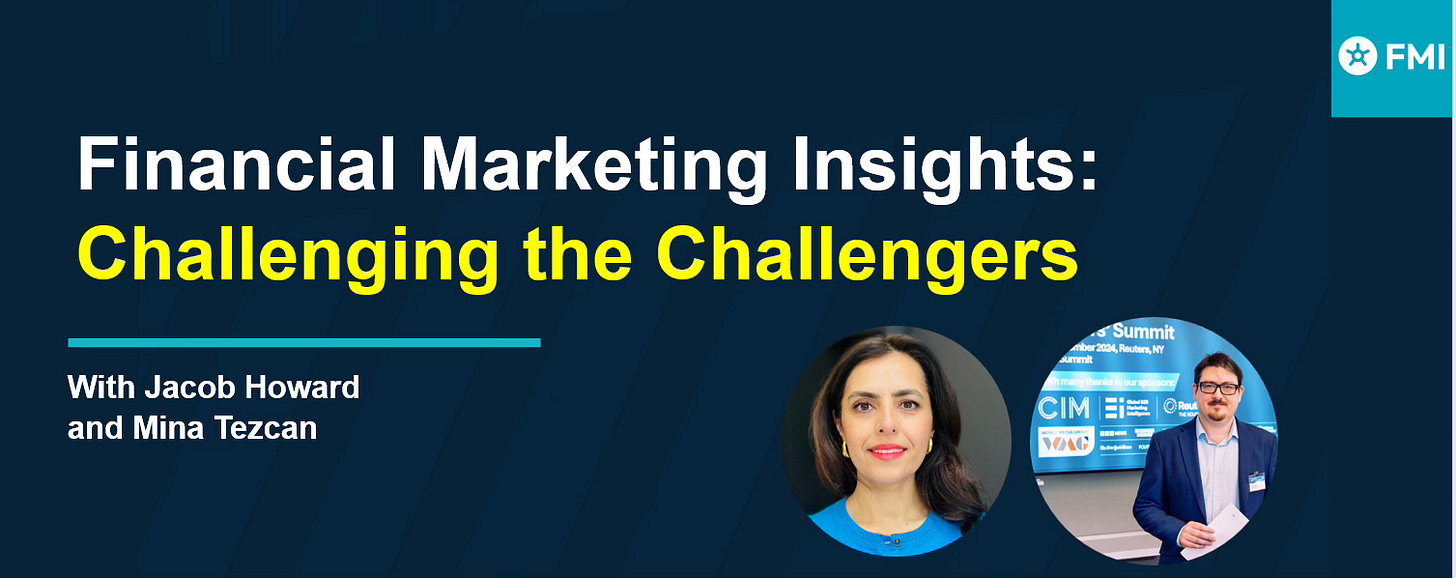Issue № 130 | London, Sunday 23 March 2025
Read on to learn why:
① If your prices need explanations, something’s gone wrong.
② Few things erode trust faster than opaque pricing structures.
③ The UK government is getting desperate in its search for growth.
④ Apologies and explanations are fine. Avoiding the need for them is better.
⑤ AI search will likely decrease your website traffic but qualify it better.
⑥ You should be attending Financial Marketing Insights events.
⑦ Great writing is tailored to its intended audience.
📸 But first, flashback to last week when we discussed Apple’s AI debacle and I told you that the line between preview and misrepresentation is thin. Well, it seems some lawyers agree with me. Last Wednesday, the Clarkson Law Firm filed a federal lawsuit in U.S. District Court in San Jose. The suit seeks class-action status, asking for unspecified damages for those who bought Apple Intelligence-ready iPhones and other hardware. Meanwhile, Tim Cook has replaced the executive in charge of AI.
What's new
St James's Place recently announced a new “cheaper” charging structure. This week, Citywire Wealth Manager examined that claim.
In short:
“SJP unveiled the latest details of its new charging structure in full-year results last month. Here are the crucial differences between the new and existing fees:
Initial product charges, of 1.5% on pensions and investment bonds and 0.5% on ISAs, have been dropped.
Initial advice charges of up to 4.5% have been cut to a range of 1-3% depending on portfolio size.
Ongoing ISA charges cut from around 1.61% to around 1.59%.
New ongoing pension and investment bond charges of around 1.67%, compared to existing charge of 0.92% in the first six years, 1.92% in the next four, and 1.77% thereafter.
New ongoing charges decrease for larger portfolios, up to a maximum discount of 10 basis points for assets above £3m.
Both new and old ongoing charges in the above examples include fund costs and can vary depending on funds selected.”
“For SJP’s ISA and unit trust customers – and any new clients buying ISAs through SJP partners – the new fees are cheaper than the old. For SJP’s pension and investment bond business, which accounts for £141bn of its £190bn in funds under management, the picture is more complicated. Rather than comparing a single ongoing charge under the new regime to its equivalent in the old structure, the new charge needs to be set against existing fees that vary in the first 11 years of a client’s investment. […] After a cheaper three years under the new charges, new pension and investment bond clients will be paying cumulatively more under the new structure after that. The new fees only become cumulatively cheaper from year 16 onwards.”
“It turns out that pension investors who sign up before the new charges come into effect will be better off. The trend is less pronounced for larger portfolios, where the impact of the tiered initial charge under the new structure comes into play. But even for a £1m portfolio, it’s still cheaper to sign up now than it will be in the second half of this year.”
Why it matters
① I read the whole 1,500 word Citywire article so you don’t have to. Before that, Citywire’s Daniel Grote poured over the SJP documentation itself and ran a model on a £250,000 portfolio in search of answers, so I didn’t have to. My point? If your charging structure requires a journalist to explain it to your customers, something’s gone wrong.
This store reminds of how complex and opaque fees typically are in financial services. And this matters because when fees aren’t clear and linked to value, when your customers can’t easily compare your fees against your competitors’, that erodes trust at an alarming rate.
Financial services and technology vendors would do well to look to consumer products for inspiration on simplifying their pricing structures.
What to do about it
Take action
Have a critical look at your pricing structure this week. Imagine you’ve explaining it to a 12-year old. If that’s a struggle, it’s time for a rethink. Your prices should:
Be clear: It should be obvious and transparent to the customer what they’re going to be paying. They should feel comfortable that they can compare you against your competitors like for like.
Be value-based: The customer should be able to draw a direct line between what they’re paying and what they’re getting. They should understand exactly how the price relates to an outcome or benefit.
Provide a tempting upgrade path: No one does this better than Apple - for a few hundred more, there’s always a more enticing configuration within reach - so imitate that. Make it easy for your customer to choose to spend more by ensuring your pricing structure is incrementally staggered.
Get help
Two ways I can help you: 1) hire me as a full-time member of your team; or 2) use InMarketing, an advisory service for senior leadership teams in finance and tech.
🔎 Audit 🧭 Strategy 🖋️ Positioning ✅ Planning 🤷🏻 Problem-solving ☎️ Counsel
Top stories
The other articles that are worthy of your time.
FINANCIAL SERVICES
Reeves promises to scrap ‘unnecessary’ financial market reporting rules
③ The UK government is getting desperate in its search for growth.
“Rachel Reeves has promised to scrap ‘duplicative and unnecessary’ reporting requirements for financial services companies by rewriting laws inherited from the EU.”
“After a meeting with chief executives of UK fintech companies on Tuesday, the chancellor said the Treasury was working on legislation to ease the rules on how much data companies have to provide to the Financial Conduct Authority.”
“The move comes as part of a wider initiative by the chancellor to streamline City regulation to boost capital markets. The Treasury said the new legislation would enable the FCA ‘to scrap any rules which are duplicative and unnecessarily hold UK firms back by designing a new regulatory framework that supports economic growth’.”
TECHNOLOGY
Monzo develops backup bank to cover outages
④ Apologies and explanations are fine. Avoiding the need for them is better.

“Engineers at Monzo have developed a fully independent backup bank — covering data, software, and infrastructure — which can be instantly activated during outages.”
“Called Monzo Stand-in, the replica platform enables customers to make payments, withdraw cash, freeze their card and send and receive bank transfers even if the main Monzo app goes down. “
“Outages in the banking industry have become a pressing concern for regulators and politicians as more customers move online. Recent figures from the UK Government Treasury Committee revealed that nine of the top banks and building societies operating in the UK accumulated at least 803 hours - the equivalent of more than 33 days - of tech outages in the last two years.”
MEDIA & MARKETING
AI search is starting to kill Google’s ‘ten blue links’
⑤ AI search will likely decrease your website traffic but qualify it better.

“After decades of relying on Google’s ten blue links to find everything from travel tips to jeans, consumers are quickly adapting to a completely new format: AI chatbots that do the searching for them.”
“According to new research from Adobe, AI search has become a significant traffic channel for retailers. [It] says AI search referrals surged 1,300 percent during the 2024 holiday season compared to 2023, with Cyber Monday seeing a 1,950 percent jump. While these are dramatic increases, it’s somewhat expected, since AI search was still in its nascency last year.”
“What’s more interesting is the engagement metrics: Users who are referred from AI search compared to traditional referrals (like a standard Google or Bing search) tend to stay on the site 8 percent longer, browse through different pages 12 percent more, and are 23 percent less likely to just visit the link and leave (or ‘bounce’). This could suggest that AI tools are directing people to more relevant pages than traditional search.”
WILDCARD
Challenging the challengers
⑥ You should be attending Financial Marketing Insights events.

Since leaving Deutsche Bank, Jacob Howard has been busy establishing Financial Marketing Insights as the go-to-source for networking and knowledge share amongst senior financial services marketers. They now run in person summits year round and around the world.
In addition to the summits, FMI hosts webinars and the next one looks particularly interesting. On 27 March, Challenging the Challengers will explore how ‘incumbent banks’ in Europe need to prepare to compete against ‘challenger banks’ in Europe – by focusing on the product offerings, brand positioning, and competitive strategies of challenger banks in the UK and Europe. It will examine real-world case studies of challenger bank marketing tactics and customer behaviours, alongside how traditional banks are responding to defend their market share.
Register for this free webinar here >
Off cuts
The stories that almost made this week’s newsletter.
FINANCIAL SERVICES
💰 Has Goldman Sachs already chosen its next CEO?
🏙️ Citi: Cuts top bankers’ bonuses and poaching wealth tech execs from rivals
🚪 Santander to shut almost a quarter of UK branch network
🇺🇸 $47bn US fund firm sets up shop in London
✂︎ Deutsche Bank to ‘cut further 2,000 jobs’
TECHNOLOGY
🤖 NatWest first UK bank to partner with OpenAI
🥇 JPMorgan leads quantum computing arms race
✂️ Lloyds overhauls IT division with 6,000 staff affected
🦾 AI adoption at UK banks lags behind US rivals
🪙 Stablecoins won't displace credit cards for consumer payments
MEDIA & MARKETING
📊 Why CMOs and marketing leaders need competitive insights to stay ahead
👏🏻 The Financial Times appoints Claire Jones as US economics editor
📲 The age of being very online is over. Heres why.
🪧 How to create a successful paid media marketing strategy
👮🏻♂️ Financial services sector calls for social media to share cost of tackling fraud
The last word
⑦ Matthew Stibbe on writing for ideal customer profiles:

“You might think good copywriting is about crafting elegant turns of phrase that flow off the page in a Byron-esque shower of romantic verbiage. Well, hate to break it to you—it’s not. What sets great marketing copy apart is its ability to speak directly to a specific audience. It’s about being readable, relevant, and, most importantly, knowing your target customer back to front.”
Don’t settle for marketing.
Aspire to InMarketing.
Wishing you an interactive week,
P.S. Always aim to get close to your customer. Just, you know, not too close.








